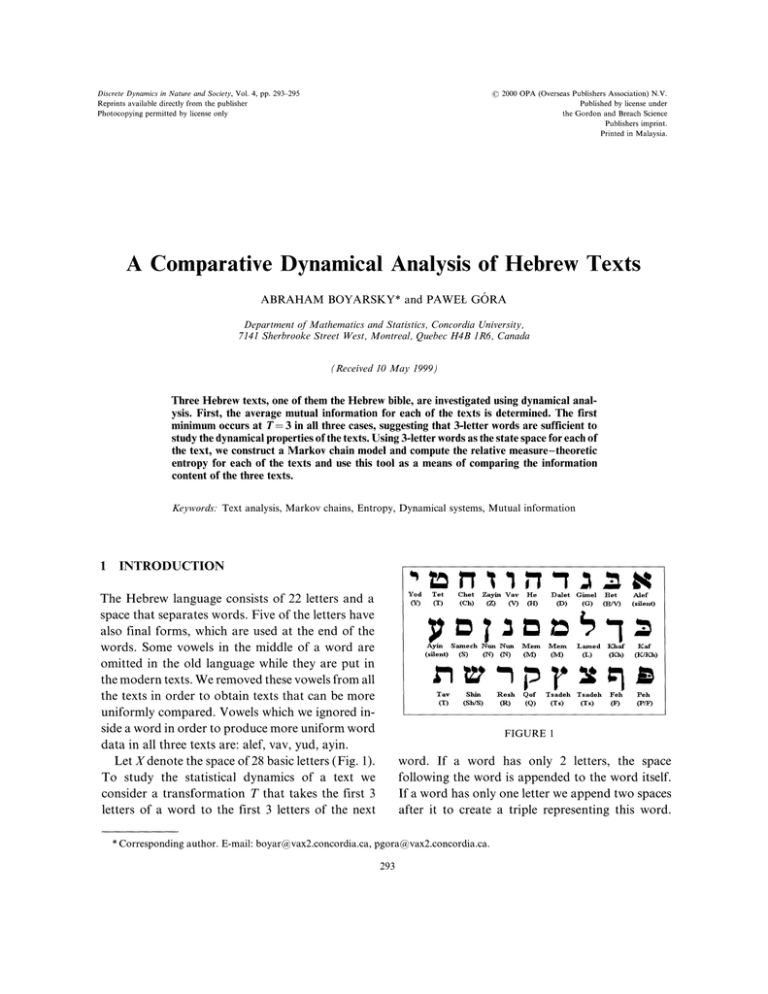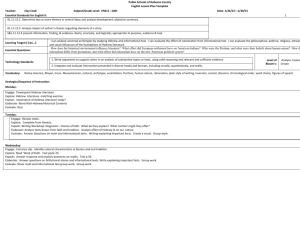Document 10852475
advertisement

(C) 2000 OPA (Overseas Publishers Association) N.V.
Published by license under
the Gordon and Breach Science
Publishers imprint.
Discrete Dynamics in Nature and Society, Vol. 4, pp. 293-295
Reprints available directly from the publisher
Photocopying permitted by license only
Printed in Malaysia.
A Comparative Dynamical Analysis of Hebrew Texts
ABRAHAM BOYARSKY* and PAWEL
GORA
Department of Mathematics and Statistics, Concordia University,
7141 Sherbrooke Street West, Montreal, Quebec H4B 1R6, Canada
(Received 10 May 1999)
Three Hebrew texts, one of them the Hebrew bible, are investigated using dynamical analysis. First, the average mutual information for each of the texts is determined. The first
minimum occurs at T: 3 in all three cases, suggesting that 3-letter words are sufficient to
study the dynamical properties of the texts. Using 3-letter words as the state space for each of
the text, we construct a Markov chain model and compute the relative measure-theoretic
entropy for each of the texts and use this tool as a means of comparing the information
content of the three texts.
Keywords: Text analysis, Markov chains, Entropy, Dynamical systems, Mutual information
1
INTRODUCTION
od
The Hebrew language consists of 22 letters and a
space that separates words. Five of the letters have
also final forms, which are used at the end of the
words. Some vowels in the middle of a word are
omitted in the old language while they are put in
the modern texts. We removed these vowels from all
the texts in order to obtain texts that can be more
uniformly compared. Vowels which we ignored inside a word in order to produce more uniform word
data in all three texts are: alef, vav, yud, ayin.
Let X denote the space of 28 basic letters (Fig. 1).
To study the statistical dynamics of a text we
consider a transformation T that takes the first 3
letters of a word to the first 3 letters of the next
(Y)
Tet
(T)
Ayin
(silent)
Tar
(T)
Chet
Zayin Vav
(Ch)
(Z)
(V)
Samech Nun N
(T) (T)
(S)
Shin
:Resh
(ss)
(R)
H:e
(H)
Dalet Gimel
(I))
((3)
]et
0/V)
1Vlem
Vl:em
Lamed
Ihaf
(Tv
(MI)
(L)
(Kh)
Qof
(Q)
Tsadeh Tsadeh
(T s)
(X s)
Feh
Alef
(silent)
(K/K)
:Peh
(F)
FIGURE
word. If a word has only 2 letters, the space
following the word is appended to the word itself.
If a word has only one letter we append two spaces
after it to create a triple representing this word.
* Corresponding author. E-mail: boyar@vax2.concordia.ca, pgora@vax2.concordia.ca.
293
A. BOYARSKY AND P.
294
In this way we obtain a data set consisting of
a sequence, each element of which is a 3-letter
sequence. Depending on the text under consideration there are approximately 7000-8000 such
3-letter admissible sequences (maximum is
27 x 28 x 28).
We use 3-letter sequences because that size presents a respectable indication of word structure
without creating an overly large space. Four-letter
sequences would create a space with hundreds of
thousands of elements, making it difficult to analyze even with the most powerful computers. Since
the average word size is between 3 and 4, 3-letter
words give a good indication of the word itself.
We suggest a number of measures for "richness"
of text. One such measure is simply based on an
average attainable set of 3-sequences. Let xyz represent a valid 3-letter sequence in a Hebrew text. We
compute all the 3-letter sequences that are attainable from xyz in the given text. We repeat this for
all possible 3-letter sequences and then compute
the average number of attainable sequences over
all admissible 3-letter sequences. A rich text will
have a relatively large such average.
The following argument supports our choice of 3letter representation of words. For all three texts,
we calculated the average mutual information
AMI(T) ([1]) between the first letter i) and the
of the word, T- 2,..., 6.
(T)th letter
xl
x(
AMI(T)
for T 2, 3 and then starts increasing, attaining the
minimum at T= 3. This shows that the fourth letter
of a word is more dependent on the first letter than
the third letter of the word. Hence the fourth letter
provides less information about the text than does
the third letter.
3
2 STATE SPACE
Z P(x{i) x)log k,pTi)7
(’)
(’)
where rx)(i) and rxi.(i)
are the probabilities
(frequencies) of individual letters and pairs of letters in the text, and changes from to the number
of words in the text (approximately 8000). For all
texts the first minimum of AMI(T) occurs at T= 3.
We interpret this fact as follows: the dependence
of the letter xron the letter Xl of the word decreases
x2i)
GISRA
ENTROPY FOR A MARKOV CHAIN
We model a text by a Markov chain on 3-letter sequences. (Textual analysis is what originally motivated Markov to introduce Markov chains in 1911
[2] and was a source of examples in Shannon’s work
on communication theory [3]. See also [4,5].)
Motivated by the results of Section 1, we use only
the first 3 letters of each word (adding extra spaces
for 1- and 2-letter words). Each word is considered
as a state and the transition probabilities are calculated from the flow of the text. We describe this
in detail now.
Let N denotes the number of words in the text.
Our texts contain around 80000 words each. In
general, we assume that the number of words is
"large". For any admissible triple of letters uvw let
Nuvw denote the number of words represented by
uvw in the text but without including the last word,
i.e., considering only words 1,2,...,N-1. Similarly, for any admissible triple of letters uvw let
N’,v denote the number of words represented by
uvw in the text but without including the first word,
i.e., considering only words 2,...,N-1,N. The
numbers N, and N’, are equal for all except at
most two admissible triples, and for these two they
differ at most by 1. We can artificially add one word
at the end to the text to make them always equal. In
the sequel we assume that they are equal, as we are
interested only in the ratios N, vw/N.
To calculate transition probabilities, for any uvw
we count the number of consecutive pairs represented by uvw and xyz, N,w, xyz and we set
Nuvw,xyz
for any admissible uvw and xyz.
DYNAMICAL ANALYSIS OF HEBREW TEXTS
We will show that the numbers P,vw N, vw/N
are stationary probabilities for this Markov chain,
if we assume N, vw/N N,vw/N, for all uvw.
PROPOSITION If Nuvw/N Nuvw/N, for all uvw,
then the numbers P,w N,w/N are stationary probabilities for the Markov chain with transition probabilities given by (1).
Z PuPw,xyz.
P*Y:
(2)
-,w
Obviously, we have NxyzN,w,xyz, for any
xyz. If Nuvw/N N,w/N, for all uvw, we can rewrite this as
Nxyz/N- Z(Nuw/N)N-uw,xz/N.uw,
W
which is equivalent to (2).
Now the entropy of the Markov chain is given by
the formula
entropy
In the following table we present the entropy and
the maximal possible entropy (as defined in [3]) for
the three texts. The maximal possible entropy is the
logarithm (to base 2) of the number of states in the
Markov chain. The numbers of different admissible
triples are different in the three texts.
Text
Proof We have to show that for any xyz
295
Hebrew bible
Hebrew text
Hebrew text 2
Entropy
3.56
3.69
3.80
Max.
Number
of triples
entropy
3586
4545
4692
11.808
12.150
12.196
The text used in analysis were: Koren text of
Hebrew bible and two books obtained in electronic
form from Bar Ilan University:
Hebrew text 1: "Hitganvut Yehidim" (Heart
Murmur) by Joshua Kenaz, published by Am
Oved Tel-Aviv, ISBN 965-13-0413-8.
Hebrew text 2: "An Autobiography" by N. Lorekh,
now a historian, formerly a military officer and
diplomat.
Z Z PuuwPuuw,x)z log(Puw,x),
uvw xyz
Acknowledgment
where the logarithm is to the base 2.
We are grateful to Prof. Y. Choueka of Bar Ilan
4 RESULTS
University for providing us with digitized versions
of two modern Hebrew texts. The Koren text
of the Hebrew bible was obtained from "http://
cs.anu.edu.au/people/bdm/dilugim/torah.html".
In this section we present the numerical results
obtained from analysis of the texts. The average
number of the possible different following words
and standard deviation of these numbers:
Text
Average
Standard deviation
Hebrew bible
Hebrew text
Hebrew text 2
106.798
97.621
76.016
138.84
142.51
115.66
References
[1] Abarbanel, H.D.I., Analysis of Observed Chaotic Data,
Springer, New York, 1996.
[2] Iosifescu, M., Finite MarKov Processes and Their Applications, J. Wiley & Sons, New York, 1980.
[3] Shannon, C.E. and Weaver, W., The Mathematical Theory of
Communication, Indiana University Press, Urbana, 1949.
[4] Gani, J., Stochastic models for type counts in a literary text,
Perspectives in Probability and Statistics (Gani, J., Ed.),
Academic Press, London, 1975, pp. 313-323.
[5] Brainerd, B., On the relation between types and tokens in
literary text, J. Appl. Prob. 9 (1972), 507- 518.







